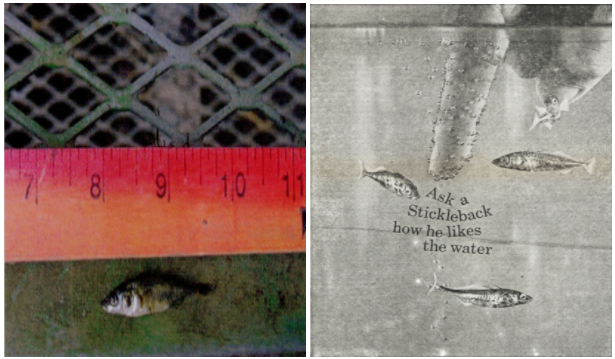Fishy Business
Photos from Reed Magazine and Reed College Quest
When you think about fish in the Reed College Canyon, you probably think of Salmon. Reed has a tradition of Salmon stewardship and encouraging the recovery of this iconic northwest species. But the lake is also home to a far smaller, more populous resident with an impressive research legacy of its own: The three spined stickleback.
In 2005, a senior biology student named Meng Qi wrote his thesis, titled “Morphological Variation in Populations of Threespine Stickleback (Gasterosteus aculeatus) in the Reed College Canyon,” studying the possible impacts of adaptive radiation on three stickleback populations living in three geographically isolated bodies of water in the reed college canyon. He found significant variations in body length, eye width, and lateral plate count between the three populations (especially at Ritmanis pond, where you stand now). His research inspired a long term study by Professor Bob Kaplan about microevolution in stickleback communities that end up in lakes. Kaplan found that freshwater populations that migrate from seawater evolve to have much less protective plating on their body on a significantly shorter timescale than what was previously thought possible- as little as 25 years- instead of 10,000-15,000.
Sticklebacks’ high sensitivity to changes in their environment, and their short lifespan also makes them well-suited to study the impacts of a rapidly evolving landscape on multiple generations of fish. Ming and Kaplan’s research came at the end of the Reed canyon’s five-year restoration plan, offering a unique species indicator for how the restoration was affecting habitat quality and ecosystem health.
VERY FUN FACT: A 1963 edition of the Reed College Quest contains an ad for the Standard Oil Company of California titled “Ask a stickleback how he likes the water,” which essentially says that the company “employs” sticklebacks (on a liberal salary of brine shrimp) to test the treated water that their refineries discharge to make sure they “like it”. So basically, they were proudly announcing that they use animal testing to make sure they only poision their test populations and not the whole watershed. Interesting...
Bibliography
Meng, Qi. "Morphological Variation in Populations of Threespine Stickleback.” Reed College, 2005.
Mentzer, Emily. “Following Darwin into Reed Canyon.” Reed magazine, vol.85:2, May 2006.
Standard Oil Company of California. “Ask a stickleback if he likes the water.” Reed College Quest Vol 52, no. 18 (February 1963): 4. https://rdc.reed.edu/i/3799a98d-529b-4dd8-af3c-13aa4ba440fd
When you think about fish in the Reed College Canyon, you probably think of Salmon. Reed has a tradition of Salmon stewardship and encouraging the recovery of this iconic northwest species. But the lake is also home to a far smaller, more populous resident with an impressive research legacy of its own: The three spined stickleback.
In 2005, a senior biology student named Meng Qi wrote his thesis, titled “Morphological Variation in Populations of Threespine Stickleback (Gasterosteus aculeatus) in the Reed College Canyon,” studying the possible impacts of adaptive radiation on three stickleback populations living in three geographically isolated bodies of water in the reed college canyon. He found significant variations in body length, eye width, and lateral plate count between the three populations (especially at Ritmanis pond, where you stand now). His research inspired a long term study by Professor Bob Kaplan about microevolution in stickleback communities that end up in lakes. Kaplan found that freshwater populations that migrate from seawater evolve to have much less protective plating on their body on a significantly shorter timescale than what was previously thought possible- as little as 25 years- instead of 10,000-15,000.
Sticklebacks’ high sensitivity to changes in their environment, and their short lifespan also makes them well-suited to study the impacts of a rapidly evolving landscape on multiple generations of fish. Ming and Kaplan’s research came at the end of the Reed canyon’s five-year restoration plan, offering a unique species indicator for how the restoration was affecting habitat quality and ecosystem health.
VERY FUN FACT: A 1963 edition of the Reed College Quest contains an ad for the Standard Oil Company of California titled “Ask a stickleback how he likes the water,” which essentially says that the company “employs” sticklebacks (on a liberal salary of brine shrimp) to test the treated water that their refineries discharge to make sure they “like it”. So basically, they were proudly announcing that they use animal testing to make sure they only poision their test populations and not the whole watershed. Interesting...
Bibliography
Meng, Qi. "Morphological Variation in Populations of Threespine Stickleback.” Reed College, 2005.
Mentzer, Emily. “Following Darwin into Reed Canyon.” Reed magazine, vol.85:2, May 2006.
Standard Oil Company of California. “Ask a stickleback if he likes the water.” Reed College Quest Vol 52, no. 18 (February 1963): 4. https://rdc.reed.edu/i/3799a98d-529b-4dd8-af3c-13aa4ba440fd

